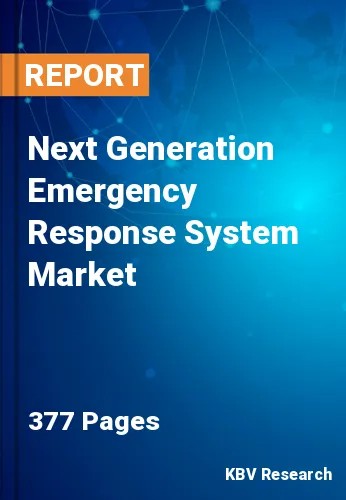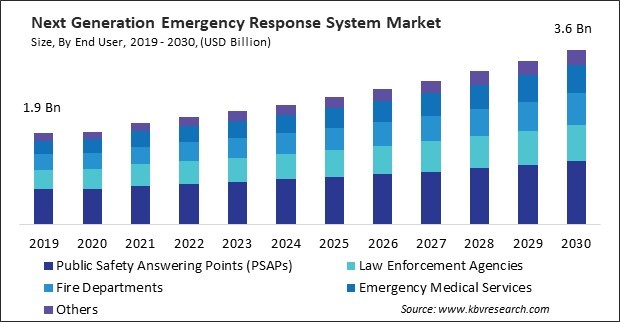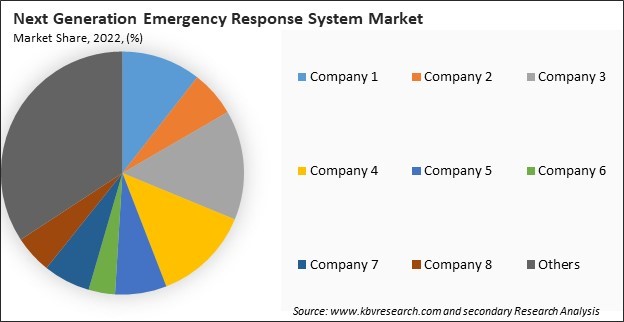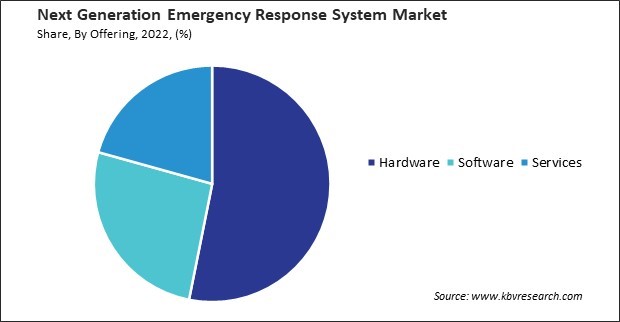
The Global Next Generation Emergency Response System Market size is expected to reach $3.6 billion by 2030, rising at a market growth of 6.4% CAGR during the forecast period.
In emergency situations, real-time communication is critical for coordinating response efforts. Network infrastructure hardware that supports low latency communication enables quick and effective decision-making by emergency responders. Consequently, the network infrastructure equipment segment would generate approximately 19.43 % share of the market by 2030. Next-generation emergency response systems often incorporate new technologies, such as IoT devices and cloud-based services.

With the rise in frequency and severity of natural disasters such as hurricanes, wildfires, floods, and earthquakes, as well as man-made emergencies like terrorist attacks and industrial accidents, there is a heightened awareness of the need for robust emergency response capabilities. Therefore, growing focus on resilience and disaster preparedness drives the market’s growth.
Additionally, Urban areas are characterized by high population density and the concentration of critical infrastructure, businesses, and resources. The proximity of people and assets in urban environments increases the vulnerability to various types of emergencies and disasters, including natural hazards, terrorist attacks, and public health crises. Hence, rapid urbanization and population growth are driving the market’s growth.
However, implementing next generation emergency response systems often requires substantial investments in infrastructure, including hardware, software, communication networks, and data centers. These systems may require deploying sensors, cameras, emergency communication devices, and command centers, which can be costly to procure, install, and maintain. Integrating disparate systems, legacy infrastructure, and third-party applications may require additional investments in consulting services, software development, and system integration, driving up costs. In conclusion, high initial investment costs are hampering the market’s growth.

The leading players in the market are competing with diverse innovative offerings to remain competitive in the market. The above illustration shows the percentage of revenue shared by some of the leading companies in the market. The leading players of the market are adopting various strategies in order to cater demand coming from the different industries. The key developmental strategies in the market are Acquisitions, and Partnerships & Collaborations.
 Drivers
Drivers  Restraints
Restraints  Opportunities
Opportunities  Challenges
Challenges Based on offering, the market is divided into hardware, software, and services. In 2022, the software segment garnered a 26.16% revenue share in the market. Software solutions form the backbone of next generation emergency response systems, integrating with advanced technologies such as IoT, AI, cloud computing, and data analytics to enhance emergency preparedness, response, and recovery capabilities. These software solutions enable real-time data collection, analysis, visualization, and communication, providing decision-makers with actionable insights and facilitating more effective response efforts.

The hardware segment is further subdivided into switching & routing equipment, call handling systems, network infrastructure equipment, and others. The switching & routing equipment garnered the 37.08 % revenue share in the market in 2022. Moreover, switching and routing hardware with built-in redundancy and failover mechanisms ensure uninterrupted communication during emergencies. These capabilities are aiding in the expansion of the segment.
On the basis of end user, the market is segmented into public safety answering points (PSAPs), law enforcement agencies, fire departments, emergency medical services, and others. The emergency medical services segment held a 15.2% revenue share in the market in 2022. With the growing population and aging demographics in many regions, there is a corresponding increase in demand for emergency medical care. Next generation emergency response systems provide EMS agencies with advanced tools and technologies to respond more efficiently to medical emergencies, including faster response times, improved patient care, and better outcomes.
Free Valuable Insights: Global Next Generation Emergency Response System Market size to reach USD 3.6 Billion by 2030
Region-wise, the market is analyzed across North America, Europe, Asia Pacific, and LAMEA. The Asia Pacific region witnessed a 27.8% revenue share in the market in 2022. The Asia-Pacific region is experiencing rapid urbanization and population growth, leading to increased demand for advanced emergency response systems to address the challenges of urban emergencies, natural disasters, and public safety threats. As cities expand and become more densely populated, there is a growing need for innovative technologies and solutions to enhance emergency preparedness and response capabilities.
| Report Attribute | Details |
|---|---|
| Market size value in 2022 | USD 2.2 Billion |
| Market size forecast in 2030 | USD 3.6 Billion |
| Base Year | 2022 |
| Historical Period | 2019 to 2021 |
| Forecast Period | 2023 to 2030 |
| Revenue Growth Rate | CAGR of 6.4% from 2023 to 2030 |
| Number of Pages | 377 |
| Number of Tables | 570 |
| Report coverage | Market Trends, Revenue Estimation and Forecast, Segmentation Analysis, Regional and Country Breakdown, Market Share Analysis, Porter’s 5 Forces Analysis, Company Profiling, Companies Strategic Developments, SWOT Analysis, Winning Imperatives |
| Segments covered | Offering, End User, Region |
| Country scope |
|
| Companies Included | Cisco Systems, Inc., Atos Group, Motorola Solutions, Inc., AT&T, Inc., Carbyne Ltd., Hexagon AB, Everbridge, Inc., Esri, Inc., Avaya, Inc. (Avaya Holdings Corp.), Sinch AB |
By Offering
By End User
By Geography
This Market size is expected to reach $3.6 billion by 2030.
Growing Focus on Resilience and Disaster Preparedness are driving the Market in coming years, however, High Initial Investment Costs of Next Generation Emergency Response Systems restraints the growth of the Market.
Cisco Systems, Inc., Atos Group, Motorola Solutions, Inc., AT&T, Inc., Carbyne Ltd., Hexagon AB, Everbridge, Inc., Esri, Inc., Avaya, Inc. (Avaya Holdings Corp.), Sinch AB
The expected CAGR of this Market is 6.4% from 2023 to 2030.
The Hardware segment is leading the Market by Offering in 2022 there by, achieving a market value of $1.9 billion by 2030.
The North America region dominated the Market by Region in 2022 there by, achieving a market value of $1.3 billion by 2030.
Our team of dedicated experts can provide you with attractive expansion opportunities for your business.
